Nutrient Utilization and Double Cropping Rice Yield Response to Dense Planting with a Decreased Nitrogen Rate in Two Different Ecological Regions of South China
Abstract
:1. Introduction
2. Materials and Methods
2.1. Site Description
2.2. Experiment Design and Field Management
2.3. Data Collection
2.3.1. The Soil Properties
2.3.2. Yield and Yield Compositions
2.3.3. Biomass and N, Phosphorus and Potassium Uptake
2.3.4. Photosynthetic Rate
2.4. Data and Analysis
3. Result
3.1. Yield and Yield Compositions
3.2. GPN, GPP and GPK
3.3. PFPN, PFPp and PFPk
3.4. Biomass
3.5. Photosynthetic Characteristics
3.6. N, Phosphorus and Potassium Uptake
3.7. Correlation between the Different Parameters and the Yield
4. Discussion
4.1. Response of Double Cropping Yield to the N Rate and Plant Density in Different Ecological Regions
4.2. Response of Nutrient Uptake and the Utilization of Double Cropping Rice to the N Rate and Plant Density in Different Ecological Regions
5. Conclusions
Author Contributions
Funding
Institutional Review Board Statement
Informed Consent Statement
Data Availability Statement
Acknowledgments
Conflicts of Interest
References
- Peng, S.; Tang, Q.; Zou, Y. Current status and challenges of rice production in China. Plant Prod. Sci. 2009, 12, 3–8. [Google Scholar] [CrossRef] [Green Version]
- Wang, W.; Chen, Q.; Hussain, S.; Mei, J.; Dong, H.; Peng, S.; Huang, J.; Cui, K.; Nie, L. Pre-sowing seed treatments in direct-seeded early rice: Consequences for emergence, seedling growth and associated metabolic events under chilling stress. Sci. Rep. 2016, 6, 19637. [Google Scholar] [CrossRef] [PubMed] [Green Version]
- Guo, J.; Liu, X.; Zhang, Y.; Shen, J.; Han, W.; Zhang, W.; Christie, P.; Goulding, K.; Vitousek, P.; Zhang, F. Signifificant acidifification in major Chinese croplands. Science 2010, 327, 1008–1010. [Google Scholar] [CrossRef] [PubMed] [Green Version]
- Fan, M.; Shen, J.; Yuan, L.; Jiang, R.; Chen, X.; Davies, W.J.; Zhang, F. Improving crop productivity and resource use efficiency to ensure food security and environmental quality in China. J. Exp. Bot. 2012, 63, 13–24. [Google Scholar] [CrossRef]
- Bonneuil, C.; Choquet, P.L.; Franta, B. Early warnings and emerging accountability: Total’s responses to global warming, 1971–2021. Glob. Environ. Chang. 2021, 71, 102386. [Google Scholar] [CrossRef]
- Song, K.; Zhang, G.; Ma, J.; Peng, S.; Lv, S.; Xu, H. Greenhouse gas emissions from ratoon rice fields among different varieties. Field Crop Res. 2022, 277, 108423. [Google Scholar] [CrossRef]
- Zhang, G.; Song, K.; Huang, Q.; Zhu, X.; Gong, H.; Ma, J.; Xu, H. Heavy metal pollution and net greenhouse gas emissions in a rice-wheat rotation system as influenced by partial organic substitution. J. Environ. Mang. 2022, 307, 114599. [Google Scholar] [CrossRef]
- Fu, D.; Xiao, M.; Hayward, A.; Fu, Y.; Liu, G.; Jiang, G.; Zhang, H. Utilization of crop heterosis: A review. Euphytica 2014, 197, 161–173. [Google Scholar] [CrossRef]
- Yan, J.; Wu, Q.; Qi, D.; Zhu, J. Rice yield, water productivity, and nitrogen use efficiency responses to nitrogen management strategies under supplementary irrigation for rain-fed rice cultivation. Agric. Water Manag. 2022, 263, 107486. [Google Scholar] [CrossRef]
- Ding, C.; Luo, X.; Wu, Q.; Lu, B.; Ding, Y.; Song, J.; Li, G. Compact plant type rice has higher lodging and N resistance under machine transplanting. J. Integr. Agric. 2021, 20, 65–77. [Google Scholar] [CrossRef]
- Yan, X.; Ti, C.; Vitousek, P.; Chen, D.; Leip, A.; Cai, Z.; Zhu, Z. Fertilizer nitrogen recovery efficiencies in crop production systems of China with and without consideration of the residual effect of nitrogen. Environ. Res. Lett. 2014, 9, 095002. [Google Scholar] [CrossRef] [Green Version]
- Varga, I.; Lončarić, Z.; Kristek, S.; Kulundžić, A.M.; Rebekić, A.; Antunović, M. Sugar beet root yield and quality with leaf seasonal dynamics in relation to planting densities and nitrogen fertilization. Agriculture 2021, 11, 407. [Google Scholar] [CrossRef]
- Liu, X.; Zhang, Y.; Han, W.; Tang, A.; Shen, J.; Cui, Z.; Zhang, F. Enhanced nitrogen deposition over China. Nature 2013, 494, 459–462. [Google Scholar] [CrossRef] [PubMed]
- Zhang, S.; Zhang, G.; Wang, D.; Liu, Q. Long-term straw return with N addition alters reactive nitrogen runoff loss and the bacterial community during rice growth stages. J. Environ. Manag. 2021, 292, 112772. [Google Scholar] [CrossRef]
- Lin, S.S.; Shen, S.L.; Zhou, A.; Lyu, H.M. Assessment and management of lake eutrophication: A case study in lake erhai, China. Sci. Total Environ. 2021, 751, 141618. [Google Scholar] [CrossRef]
- Sha, M.; Xu, J.; Zheng, Z.; Fa, K. Enhanced atmospheric nitrogen deposition triggered little change in soil microbial diversity and structure in a desert ecosystem. Glob. Ecol. Conserv. 2021, 31, e01879. [Google Scholar] [CrossRef]
- Liu, S.; Li, L.; Fan, H.; Guo, X.; Wang, S.; Lu, J. Real-time and multi-stage recommendations for nitrogen fertilizer topdressing rates in winter oilseed rape based on canopy hyperspectral data. Ind. Crop Prod. 2020, 154, 112699. [Google Scholar] [CrossRef]
- Lyu, Y.; Yang, X.; Pan, H.; Zhang, X.; Cao, H.; Ulgiati, S.; Xiao, Y. Impact of fertilization schemes with different ratios of urea to controlled release nitrogen fertilizer on environmental sustainability, nitrogen use efficiency and economic benefit of rice production: A study case from Southwest China. J. Clean. Prod. 2021, 293, 126198. [Google Scholar] [CrossRef]
- Zhu, C.H.; Ouyang, Y.Y.; You, D.I.A.O.; Yu, J.Q.; Xi, L.U.O.; Zheng, J.G.; Li, X.Y. Effects of mechanized deep placement of nitrogen fertilizer rate and type on rice yield and nitrogen use efficiency in Chuanxi Plain, China. J. Integr. Agric. 2021, 20, 581–592. [Google Scholar] [CrossRef]
- Wan, X.; Wu, W.; Shah, F. Nitrogen fertilizer management for mitigating ammonia emission and increasing nitrogen use efficiencies by 15N stable isotopes in winter wheat. Sci. Total Environ. 2021, 790, 147587. [Google Scholar] [CrossRef]
- Zheng, H.B.; Chen, Y.W.; Chen, Q.M.; Li, B.; Zhang, Y.S.; Jia, W.; Mo, W.W.; Tang, Q.Y. High-density planting with lower nitrogen application increased early rice production in a double-season rice system. Agron. J. 2020, 112, 205–214. [Google Scholar] [CrossRef] [Green Version]
- Wei, H.; Meng, T.; Ge, J.; Zhang, X.; Shi, T.; Ding, E.; Dai, Q. Reduced nitrogen application rate with dense planting improves rice grain yield and nitrogen use efficiency: A case study in east China. Crop J. 2021, 9, 954–961. [Google Scholar] [CrossRef]
- Fu, Y.Q.; Zhong, X.H.; Zeng, J.H.; Liang, K.M.; Pan, J.F.; Xin, Y.F.; Huang, N.R. Improving grain yield, nitrogen use efficiency and radiation use efficiency by dense planting, with delayed and reduced nitrogen application, in double cropping rice in South China. J. Integr. Agric. 2021, 20, 565–580. [Google Scholar] [CrossRef]
- Chen, J.; Zhu, X.; Xie, J.; Deng, G.; Tu, T.; Guan, X.; Peng, C. Reducing nitrogen application with dense planting increases nitrogen use efficiency by maintaining root growth in a double-rice cropping system. Crop J. 2021, 9, 805–815. [Google Scholar] [CrossRef]
- Hu, Q.; Jiang, W.Q.; Shi, Q.; Xing, Z.P.; Hu, Y.J.; Guo, B.W.; Wei, H.Y. Effect of wide-narrow row arrangement in mechanical pot-seedling transplanting and plant density on yield formation and grain quality of japonica rice. J. Integr. Agric. 2020, 19, 1197–1214. [Google Scholar] [CrossRef]
- Sun, T.; Yang, X.; Tan, X.; Han, K.; Tang, S.; Tong, W.; Zhu, S.; Hu, Z.; Wu, L. Comparison of Agronomic Performance between Japonica/Indica Hybrid and Japonica Cultivars of Rice Based on Different Nitrogen Rates. Agronomy 2020, 10, 171. [Google Scholar] [CrossRef] [Green Version]
- Meng, T.; Chen, X.; Ge, J.; Zhang, X.; Zhou, G.; Dai, Q.; Wei, H. Reduced nitrogen rate with increased planting density facilitated grain yield and nitrogen use efficiency in modern conventional Japonica rice. Agriculture 2021, 11, 1188. [Google Scholar] [CrossRef]
- Awan, T.H.; Cruz, P.C.S.; Chauhan, B.S. Growth analysis and biomass partitioning of Cyperusiria in response to rice planting density and nitrogen rate. Crop Prot. 2015, 74, 92–102. [Google Scholar] [CrossRef]
- Zhu, X.; Zhang, J.; Zhang, Z.; Deng, A.; Zhang, W. Dense planting with less basal nitrogen fertilization might benefit rice cropping for high yield with less environmental impacts. Eur. J. Agron. 2016, 75, 50–59. [Google Scholar] [CrossRef]
- Hou, W.; Khan, M.R.; Zhang, J.; Lu, J.; Ren, T.; Cong, R.; Li, X. Nitrogen rate and plant density interaction enhances radiation interception, yield and nitrogen use efficiency of mechanically transplanted rice. Agric. Ecosyst. Environ. 2019, 269, 183–192. [Google Scholar] [CrossRef]
- Huang, M.; Chen, J.; Cao, F.; Zou, Y. Increased hill density can compensate for yield loss from reduced nitrogen input in machine-transplanted double-cropped rice. Field Crops Res. 2018, 221, 333–338. [Google Scholar] [CrossRef]
- Sun, B.; Zhou, S.; Zhao, Q. Evaluation of spatial and temporal changes of soil quality based on geostatistical analysis in the hill region of subtropical China. Geoderma 2003, 115, 85–99. [Google Scholar] [CrossRef]
- Wang, X.; Gong, Z. Assessment and analysis of soil quality changes after eleven years of reclamation in subtropical China. Geoderma 1998, 81, 339–355. [Google Scholar] [CrossRef]
- Liao, P.; Huang, S.; Van Gestel, N.; Zeng, Y.; Wu, Z.; Van Groenigen, K. Liming and straw retention interact to increase nitrogen uptake and grain yield in a double rice-cropping system. Field Crops Res. 2018, 216, 217–224. [Google Scholar] [CrossRef]
- Nishigaki, T.; Tsujimoto, Y.; Rinasoa, S.; Rakotoson, T.; Andriamananjara, A.; Razafimbelo, T. Phosphorus uptake of rice plants is affected by phosphorus forms and physicochemical properties of tropical weathered soils. Plant Soil 2019, 435, 27–38. [Google Scholar] [CrossRef] [Green Version]
- Pansu, D.; Gautheyrou, J. Handbook of Soil Analysis: Mineralogical, Organic and Inorganic Methods; Springer Science & Business Media: Heidelberg, Germany, 2007. [Google Scholar]
- Ju, C.; Buresh, R.J.; Wang, Z.; Zhang, H.; Liu, L.; Yang, J.; Zhang, J. Root and shoot traits for rice varieties with higher grain yield and higher nitrogen use efficiency at lower nitrogen rates application. Field Crops Res. 2015, 175, 47–55. [Google Scholar] [CrossRef]
- Fang, Y.; Ren, T.; Zhang, S.; Liu, Y.; Liao, S.; Li, X.; Cong, R.; Lu, J. Rotation with oilseed rape as the winter crop enhances rice yield and improves soil indigenous nutrient supply. Soil Tillage Res. 2021, 212, 105065. [Google Scholar] [CrossRef]
- Dinh, V.; Nguyen, H.; Nguyen, A.; Nguyen, T.; Nguyen, T.; Uteau, D.; Nguyen, N.; Tran, T.; Dultz, S.; Nguyen, M. Pelletized rice-straw biochar as a slow-release delivery medium: Potential routes for storing and serving of phosphorus and potassium. J. Environ. Chem. Eng. 2022, 10, 107237. [Google Scholar] [CrossRef]
- Guo, X.; Lan, Y.; Xu, L.; Yin, D.; Li, H.; Qian, Y.; Zheng, G.; Lv, Y. Effects of nitrogen application rate and hill density on rice yield and nitrogen utilization in sodic saline–alkaline padd field. J. Integr. Agric. 2021, 20, 540–553. [Google Scholar] [CrossRef]
- Zhang, X.; Davidson, E.; Mauzerall, D.; Searchinger, T.; Dumas, P.; Shen, Y. Managing nitrogen for sustainable development. Nature 2015, 528, 51–59. [Google Scholar] [CrossRef] [Green Version]
- Zhang, F.; Cui, Z.; Chen, X.; Ju, X.; Shen, J.; Chen, Q.; Liu, X.; Zhang, W.; Mi, G.; Fan, M.; et al. Integrated nutrient management for food security and environmental quality in China. Adv. Agron. 2012, 116, 1–40. [Google Scholar] [CrossRef]
- Wang, X.; Fan, J.; Xing, Y.; Xu, G.; Wang, H.; Deng, J.; Wang, Y.; Zhang, F.; Li, P.; Li, Z. The Effects of Mulch and Nitrogen Fertilizer on the Soil Environment of Crop Plants. Adv. Agron. 2019, 153, 121–173. [Google Scholar] [CrossRef]
- Huang, M.; Jiang, P.; Shan, S.; Gao, W.; Ma, G.; Zou, Y.; Uphoff, N.; Yuan, L. Higher yields of hybrid rice do not depend on nitrogen fertilization under moderate to high soil fertility conditions. Rice 2017, 10, 43. [Google Scholar] [CrossRef] [PubMed] [Green Version]
- Zhou, B.; Sun, X.; Wang, D.; Ding, Z.; Li, C.; Ma, W.; Zhao, M. Integrated agronomic practice increases maize grain yield and nitrogen use efficiency under various soil fertility conditions. Crop J. 2019, 7, 527–538. [Google Scholar] [CrossRef]
- Huang, M.; Yang, C.; Ji, Q.; Jiang, L.; Tan, J.; Li, Y. Tillering responses of rice to plant density and nitrogen rate in a subtropical environment of southern China. Field Crops Res. 2013, 149, 187–192. [Google Scholar] [CrossRef]
- Xie, X.; Shan, S.; Wang, Y.; Cao, F.; Chen, J.; Huang, M.; Zou, Y. Dense planting with reducing nitrogen rate increased grain yield and nitrogen use efficiency in two hybrid rice varieties across two light conditions. Field Crops Res. 2019, 236, 24–32. [Google Scholar] [CrossRef]
- Li, X.; Li, Z.; Xie, Y.; Wang, B.; Kuai, J.; Zhou, G. An improvement in oilseed rape (Brassica napus L.) productivity through optimization of rice-straw quantity and plant density. Field Crops Res. 2021, 273, 108290. [Google Scholar] [CrossRef]
- Chauhan, B.; Abugho, S. Effects of water regime, nitrogen fertilization, and rice plant density on growth and reproduction of lowland weed Echinochloa crus-galli. Crop Prot. 2013, 54, 142–147. [Google Scholar] [CrossRef]
- Clerget, B.; Bueno, C.; Domingo, A.; Layaoen, H.; Vial, L. Leaf emergence, tillering, plant growth, and yield in response to plant density in a high-yielding aerobic rice Crop. Field Crops Res. 2016, 199, 52–64. [Google Scholar] [CrossRef]
- Shankar, T.; Banerjee, M.; Malik, G.C.; Dutta, S.; Maiti, D.; Maitra, S.; Alharby, H.; Bamagoos, A.; Hossain, A.; Ismail, I.A.; et al. The productivity and nutrient use efficiency of rice–rice–black gram cropping sequence are influenced by location specific nutrient management. Sustainability 2021, 13, 3222. [Google Scholar] [CrossRef]
- Shankar, T.; Malik, G.C.; Banerjee, M.; Dutta, S.; Maitra, S.; Praharaj, S.; Sairam, M.; Kumar, D.S.; Dessoky, E.S.; Hassan, M.M.; et al. Productivity and nutrient balance of an intensive rice–rice cropping system are influenced by different nutrient management in the red and lateritic belt of west bengal. India. Plants 2021, 10, 1622. [Google Scholar] [CrossRef] [PubMed]
- Chew, J.; Joseph, S.; Chen, G.; Zhang, Y.; Zhu, L.; Liu, M.; Taherymoosavi, S.; Munroe, P.; Mitchell, D.; Pan, G.; et al. Biochar-based fertiliser enhances nutrient uptake and transport in rice seedlings. Sci Total Environ. 2022, 826, 154174. [Google Scholar] [CrossRef] [PubMed]
- Cuong, T.; Ullah, H.; Datta, A.; Hanh, T. Effects of silicon-based fertilizer on growth, yield and nutrient uptake of rice in tropical zone of Vietnam. Rice Sci. 2017, 24, 283–290. [Google Scholar] [CrossRef]
- Bakhshandeh, E.; Pirdashti, H.; Gilani, Z. Application of mathematical models to describe rice growth and nutrients uptake in the presence of plant growth promoting microorganisms. Appl. Soil Ecol. 2018, 124, 171–184. [Google Scholar] [CrossRef]
- Cui, N.; Zhang, X.; Cai, M.; Chen, G.; Zhou, L.; Zou, G. Does rice straw addition and/or Vallisneria natans (Lour.) planting contribute to enhancement in nitrate nitrogen and phosphorus removal in constructed wetlands under low temperature? Bioresour. Technol. 2022, 350, 126896. [Google Scholar] [CrossRef]
- Zhao, W.; Liang, B.; Yang, X.; Gale, W.; Zhou, J. Effect of long-term fertilization on 15N uptake and Retention in soil. J. Plant Nutr. 2016, 39, 1413–1440. [Google Scholar] [CrossRef]
- Huang, J.; Wu, J.; Chen, H.; Zhang, Z.; Fang, C.; Shao, C.; Lin, W.; Weng, P.; Muhammad, U.; Lin, W. Optimal management of nitrogen fertilizer in the main rice crop and its carrying-over effect on ratoon rice under mechanized cultivation in Southeast China. J. Integr. Agric. 2022, 21, 351–364. [Google Scholar] [CrossRef]
- Fu, H.; Cui, D.; Shen, H. Effects of nitrogen forms and application rates on nitrogen uptake, photosynthetic characteristics and yield of double-cropping rice in South China. Agronomy 2021, 11, 158. [Google Scholar] [CrossRef]
- Dou, Z.; Li, Y.; Guo, H.; Chen, L.; Jiang, J.; Zhou, Y.; Xu, Q.; Xing, Z.; Gao, H.; Zhang, H. Effects of mechanically transplanting methods and planting densities on yield and quality of Nanjing 2728 under rice-crayfish continuous production system. Agronomy 2021, 11, 488. [Google Scholar] [CrossRef]
- Ma, P.; Lan, Y.; Lv, X.; Fan, P.; Yang, Z.; Sun, Y.; Zhang, R.; Ma, J. Reasonable Nitrogen Fertilizer Management Improves Rice Yield and Quality under a Rapeseed/Wheat-Rice Rotation System. Agriculture 2021, 11, 490. [Google Scholar] [CrossRef]
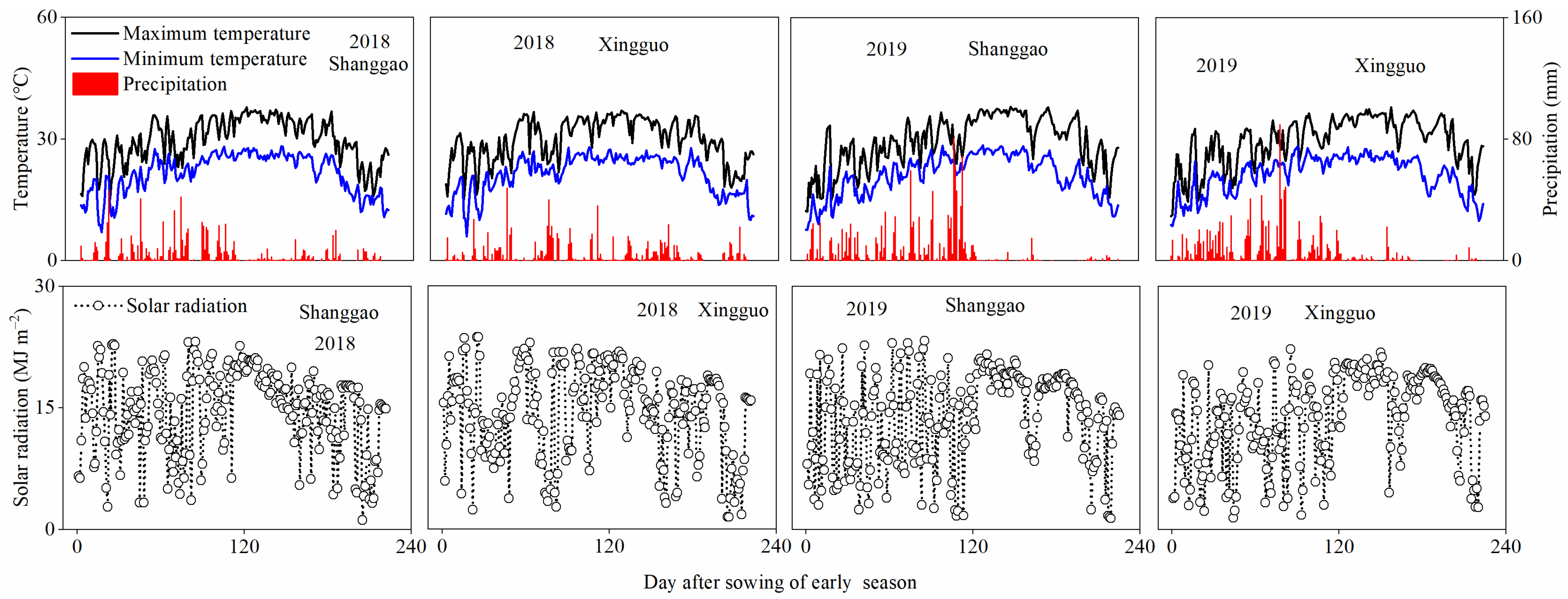
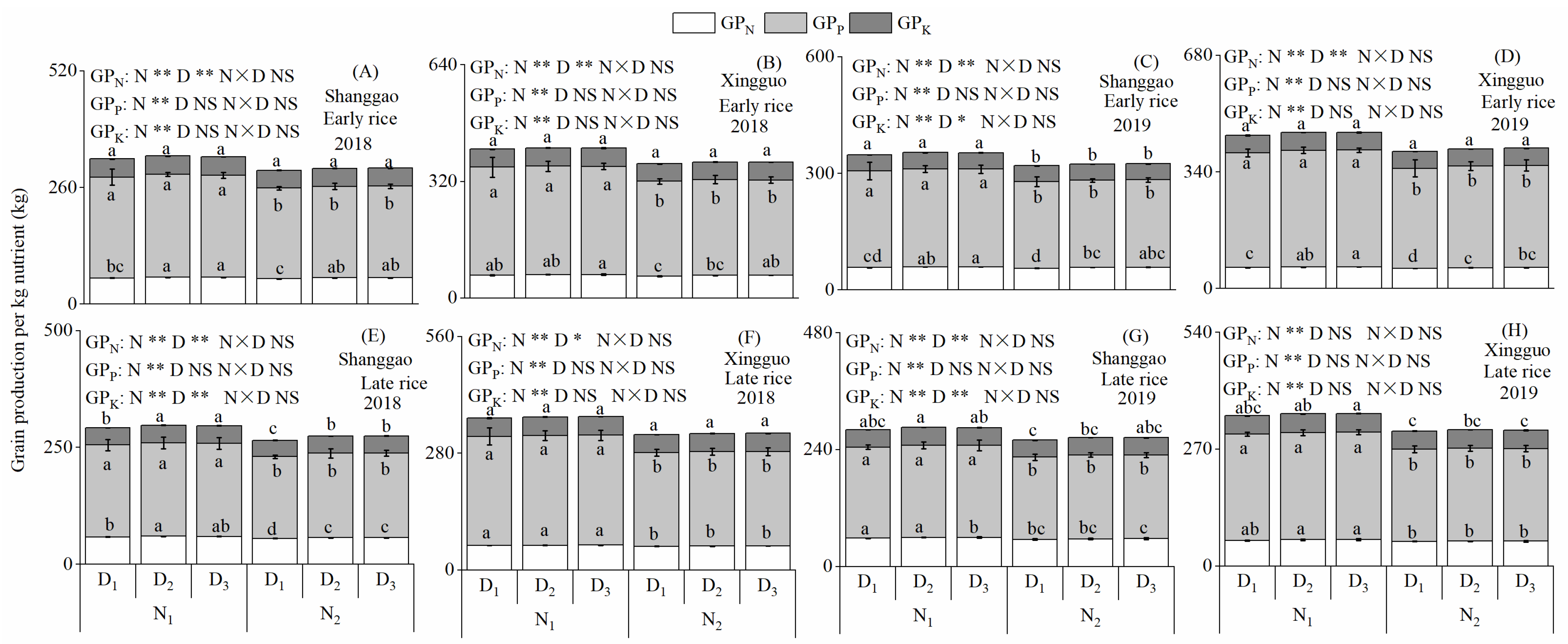

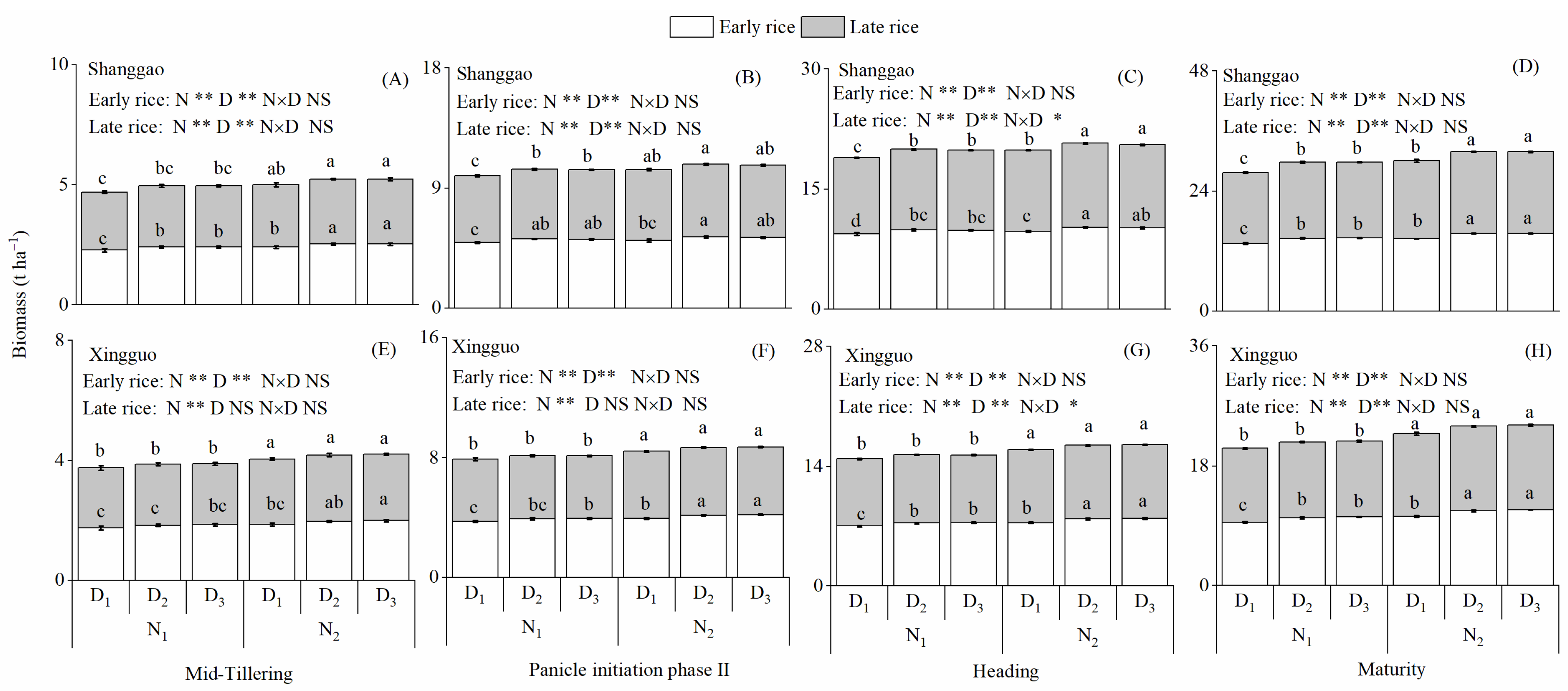
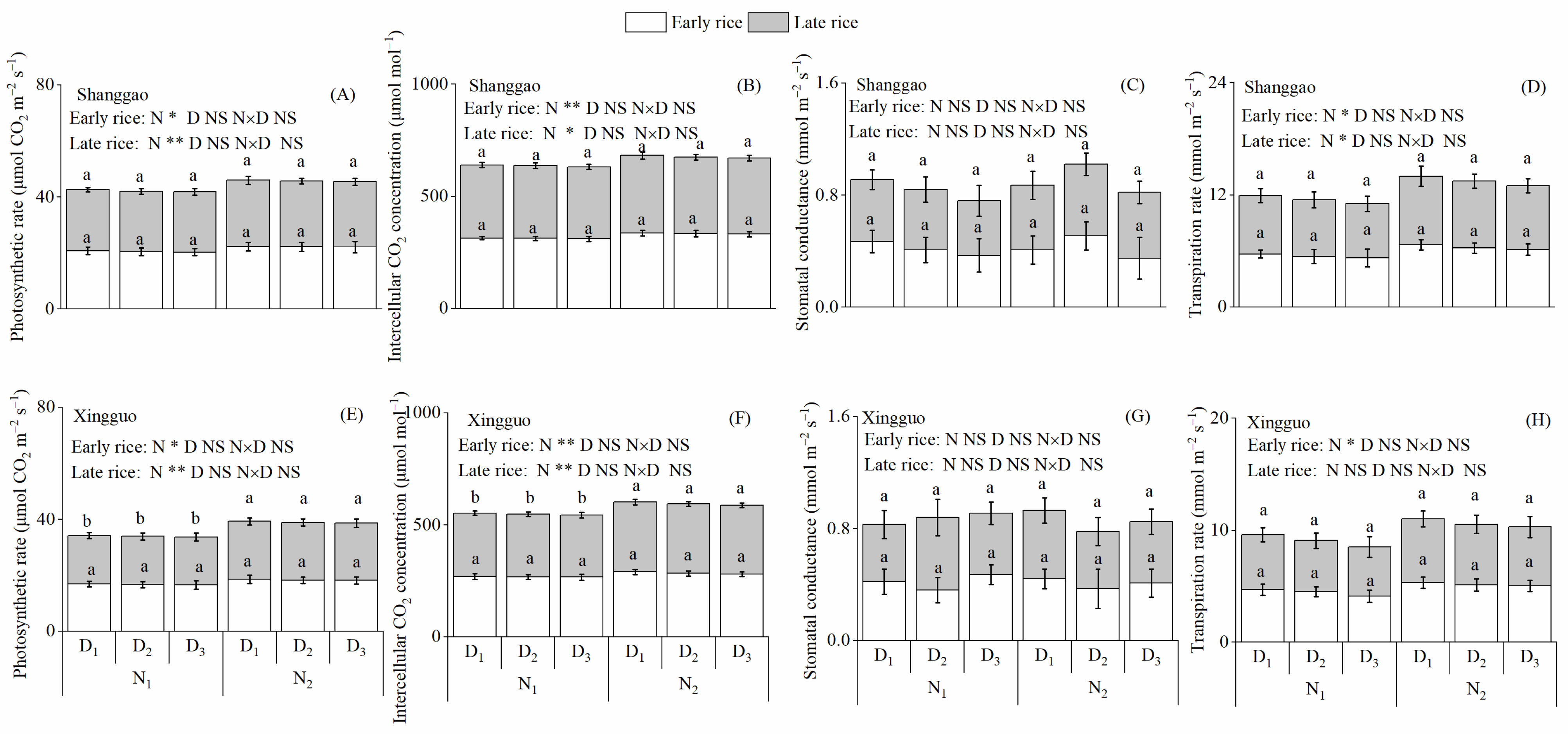
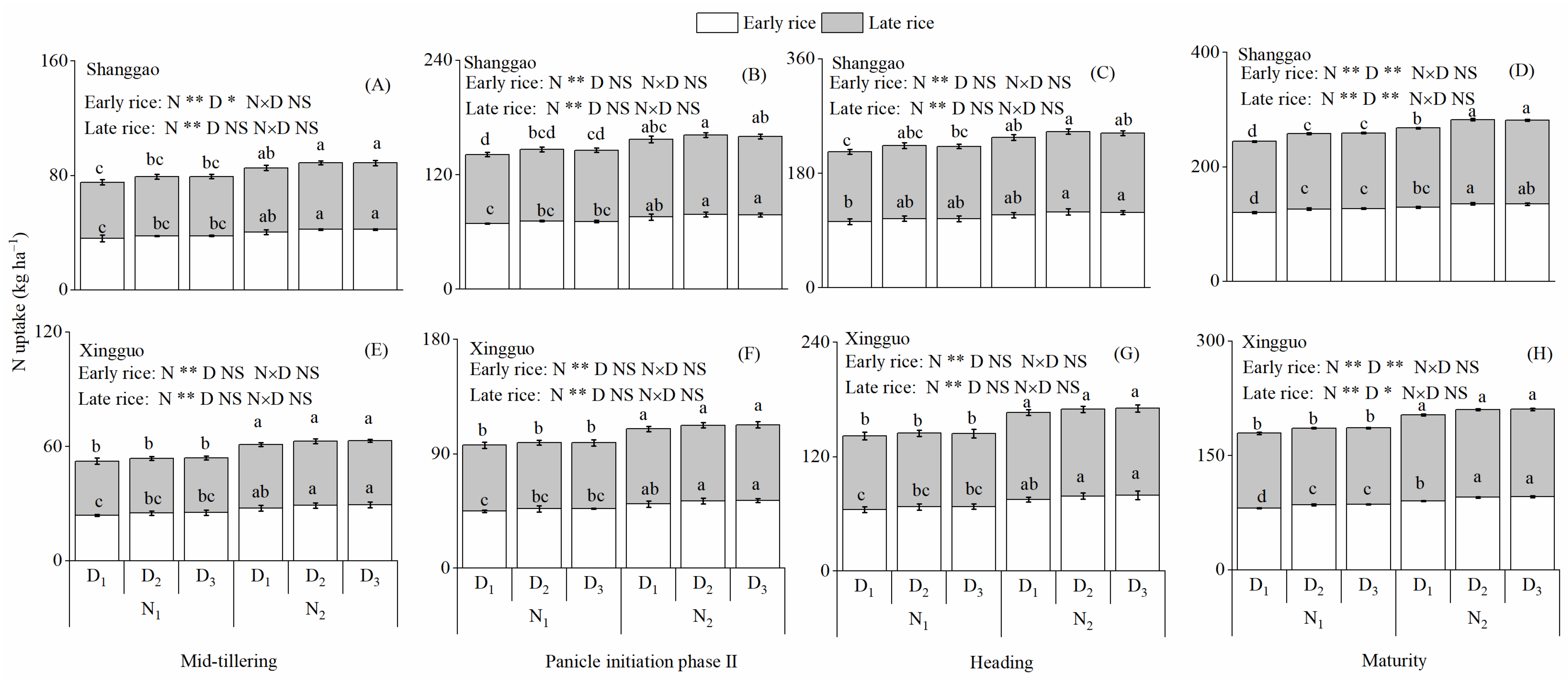
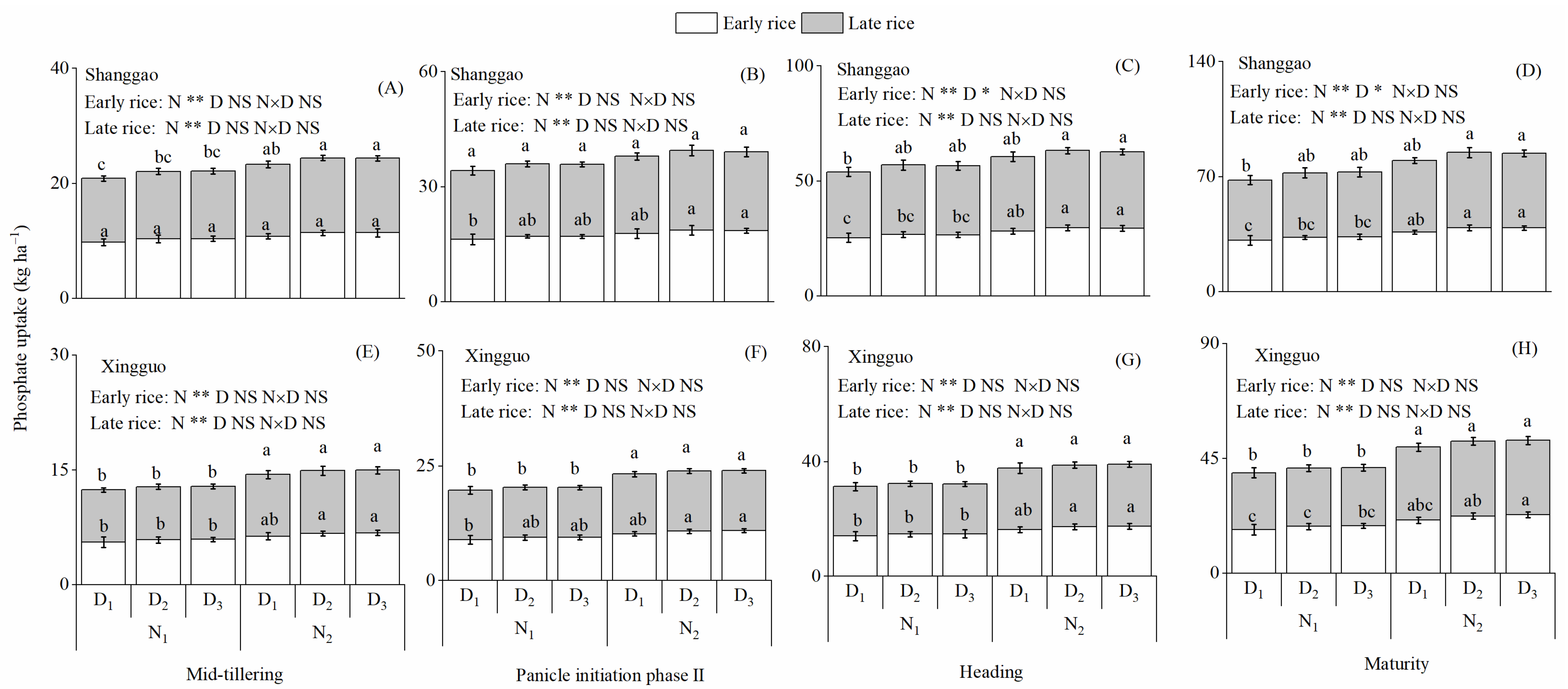


| Season | Treatment | Panicle Number (×104 hm−2) | Spikelets per Panicle | Spikelet Filling Percentage (%) | Thousand Kernel Weight (g) | Yield (t ha−1) | |||||
|---|---|---|---|---|---|---|---|---|---|---|---|
| 2018 | 2019 | 2018 | 2019 | 2018 | 2019 | 2018 | 2019 | 2018 | 2019 | ||
| Early | N1D1 | 331.03e | 321.87e | 131.1a | 130.59a | 70.19d | 70.39b | 25.11a | 25.07a | 6.98c | 6.83c |
| rice | N1D2 | 410.50c | 398.56c | 112.62b | 111.68b | 71.39c | 71.09b | 25.06a | 25.11a | 7.57b | 7.42b |
| N1D3 | 466.22a | 445.96a | 95.35c | 94.68c | 74.29b | 73.89a | 25.16a | 25.21a | 7.59b | 7.44b | |
| N2D1 | 346.27d | 335.69d | 129.95a | 128.79a | 70.05d | 70.59b | 25.14a | 25.17a | 7.31b | 7.16b | |
| N2D2 | 420.40b | 407.59b | 113.52b | 110.68b | 74.10b | 74.89a | 25.08a | 25.07a | 7.92a | 7.77a | |
| N2D3 | 460.79a | 449.16a | 98.53c | 97.89c | 75.44a | 74.99a | 25.21a | 25.16a | 7.91a | 7.76a | |
| N | 20.48 ** | 169.73 ** | NS | NS | 34.55 ** | 60.69 ** | NS | NS | 137.11 ** | 604.84 ** | |
| D | 2508.89 ** | 10,808.49 ** | 207.34 ** | 1323.97 ** | 169.28 ** | 111.80 ** | NS | NS | 199.10 ** | 878.29 ** | |
| N × D | 18.21 ** | 21.22 ** | NS | 8.56 ** | 15.26 ** | 24.57 ** | NS | NS | NS | NS | |
| Late | N1D1 | 389.35d | 399.52d | 129.56a | 126.89ab | 77.82b | 77.49b | 18.87a | 18.92a | 7.21c | 7.33c |
| rice | N1D2 | 417.95c | 428.20c | 124.42b | 124.42ab | 80.25ab | 80.35ab | 18.92a | 18.93a | 7.81b | 8.01b |
| N1D3 | 441.83ab | 452.14b | 117.33c | 117.00b | 81.54a | 82.05a | 18.91a | 18.73a | 7.82b | 8.04b | |
| N2D1 | 411.08c | 422.19c | 129.12a | 128.79a | 78.58b | 78.51b | 18.89a | 18.90a | 7.61b | 7.87b | |
| N2D2 | 437.39b | 451.70b | 124.57b | 124.57ab | 80.54ab | 79.83ab | 18.92a | 18.94a | 8.26a | 8.47a | |
| N2D3 | 457.70a | 470.29a | 120.32c | 121.32ab | 81.12a | 80.79ab | 18.87a | 18.91a | 8.24a | 8.51a | |
| N | 109.51 ** | 58.40 ** | NS | NS | NS | NS | NS | NS | 337.43 ** | 566.67 ** | |
| D | 248.96 ** | 108.30 ** | 121.50 ** | 20.40 ** | 51.93 ** | 16.15 ** | NS | NS | 324.29 ** | 454.43 ** | |
| N × D | NS | NS | NS | NS | NS | NS | NS | NS | NS | NS | |
| Season | Treatment | Panicle Number (×104 hm−2) | Spikelets per Panicle | Spikelet Filling Percentage (%) | Thousand Kernel Weight (g) | Yield (t ha−1) | |||||
|---|---|---|---|---|---|---|---|---|---|---|---|
| 2018 | 2019 | 2018 | 2019 | 2018 | 2019 | 2018 | 2019 | 2018 | 2019 | ||
| Early | N1D1 | 227.28e | 224.69e | 125.24a | 124.13a | 71.59d | 71.08d | 25.37a | 25.38a | 5.06c | 4.91c |
| rice | N1D2 | 259.21c | 256.89c | 112.81b | 111.70b | 75.71c | 75.20c | 25.35a | 25.29a | 5.47b | 5.32b |
| N1D3 | 292.07b | 288.79b | 95.25c | 94.14c | 80.91a | 80.40a | 25.33a | 25.24a | 5.55b | 5.40b | |
| N2D1 | 239.33d | 236.71d | 126.13a | 125.02a | 71.58d | 71.07d | 25.39a | 25.39a | 5.42b | 5.27b | |
| N2D2 | 300.32b | 292.78b | 111.55b | 110.44b | 76.52c | 76.01c | 25.36a | 25.17a | 5.91a | 5.76a | |
| N2D3 | 332.56a | 328.94a | 98.82c | 97.71c | 77.85b | 77.34b | 25.15a | 25.23a | 6.01a | 5.86a | |
| N | 67.19 ** | 201.98 ** | NS | NS | NS | 29.58 ** | NS | NS | 204.24 ** | 279.84 ** | |
| D | 144.96 ** | 480.06 ** | 61.85 ** | 663.04 ** | 172.81 ** | 1065.02 ** | NS | NS | 129.21 ** | 177.04 ** | |
| N × D | 6.33 * | 17.96 ** | NS | 4.72 * | 11.72 ** | 72.26 ** | NS | NS | NS | NS | |
| Late | N1D1 | 320.74d | 331.02d | 126.64a | 126.33a | 76.18a | 76.91a | 18.89a | 18.93a | 5.77c | 5.94c |
| rice | N1D2 | 364.76b | 375.19bc | 120.12bc | 120.12ab | 72.95bc | 73.62ab | 18.90a | 18.93a | 5.98b | 6.25b |
| N1D3 | 389.78a | 400.35a | 116.89c | 116.89b | 70.26c | 70.79b | 18.89a | 18.94a | 5.96b | 6.27b | |
| N2D1 | 345.17c | 358.73c | 127.38a | 127.38a | 77.35a | 77.26a | 18.88a | 18.91a | 6.41a | 6.58a | |
| N2D2 | 379.77ab | 390.19ab | 124.13ab | 124.46ab | 74.48ab | 75.33ab | 18.91a | 18.91a | 6.60a | 6.75a | |
| N2D3 | 398.08a | 408.61a | 120.25c | 119.25b | 72.96bc | 73.57b | 18.90a | 18.93a | 6.58a | 6.71a | |
| N | 201.95 ** | 49.35 ** | 34.87 ** | 10.22 ** | 9.37 * | NS | NS | NS | 1550.18 ** | 1159.32 ** | |
| D | 1015.87 ** | 207.35 ** | 114.23 ** | 39.45 ** | 25.90 ** | 13.44 ** | NS | NS | 63.86 ** | 102.72 ** | |
| N × D | 17.48 ** | 5.56 * | 4.77 * | NS | NS | NS | NS | NS | NS | 14.67 ** | |
Publisher’s Note: MDPI stays neutral with regard to jurisdictional claims in published maps and institutional affiliations. |
© 2022 by the authors. Licensee MDPI, Basel, Switzerland. This article is an open access article distributed under the terms and conditions of the Creative Commons Attribution (CC BY) license (https://creativecommons.org/licenses/by/4.0/).
Share and Cite
Luo, K.; Zeng, Y.; Wu, Z.; Guo, L.; Xie, X.; Shi, Q.; Pan, X. Nutrient Utilization and Double Cropping Rice Yield Response to Dense Planting with a Decreased Nitrogen Rate in Two Different Ecological Regions of South China. Agriculture 2022, 12, 871. https://doi.org/10.3390/agriculture12060871
Luo K, Zeng Y, Wu Z, Guo L, Xie X, Shi Q, Pan X. Nutrient Utilization and Double Cropping Rice Yield Response to Dense Planting with a Decreased Nitrogen Rate in Two Different Ecological Regions of South China. Agriculture. 2022; 12(6):871. https://doi.org/10.3390/agriculture12060871
Chicago/Turabian StyleLuo, Kang, Yongjun Zeng, Ziming Wu, Lin Guo, Xiaobing Xie, Qinghua Shi, and Xiaohua Pan. 2022. "Nutrient Utilization and Double Cropping Rice Yield Response to Dense Planting with a Decreased Nitrogen Rate in Two Different Ecological Regions of South China" Agriculture 12, no. 6: 871. https://doi.org/10.3390/agriculture12060871
APA StyleLuo, K., Zeng, Y., Wu, Z., Guo, L., Xie, X., Shi, Q., & Pan, X. (2022). Nutrient Utilization and Double Cropping Rice Yield Response to Dense Planting with a Decreased Nitrogen Rate in Two Different Ecological Regions of South China. Agriculture, 12(6), 871. https://doi.org/10.3390/agriculture12060871





